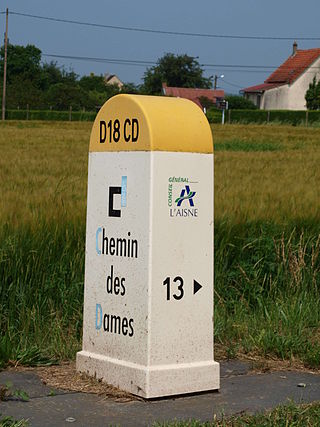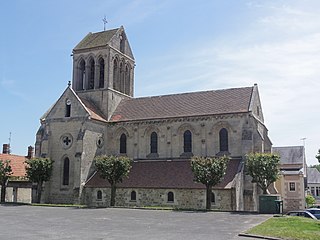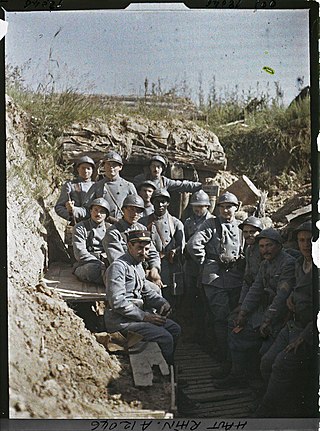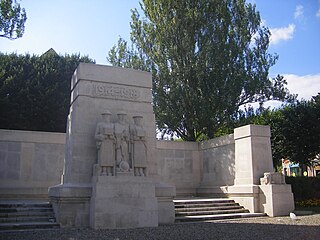
Aisne is a French department in the Hauts-de-France region of northern France. It is named after the river Aisne. In 2019, it had a population of 531,345.

The First Battle of the Marne was a battle of the First World War fought from 5 to 12 September 1914. It was fought in a collection of skirmishes around the Marne River Valley. It resulted in an Entente victory against the German armies in the west. The battle was the culmination of the Retreat from Mons and pursuit of the Franco-British armies which followed the Battle of the Frontiers in August and reached the eastern outskirts of Paris.

In France, the Chemin des Dames is part of the route départementale D18 and runs east and west in the Aisne department, between in the west, the Route Nationale 2, and in the east, the D1044 at Corbeny. It is some 30 kilometres (19 mi) long and runs along a ridge between the valleys of the rivers Aisne and Ailette.

The Race to the Sea took place from about 17 September – 19 October 1914 during the First World War, after the Battle of the Frontiers and the German advance into France. The invasion had been stopped at the First Battle of the Marne (5–12 September) and was followed by the First Battle of the Aisne (13–28 September), a Franco-British counter-offensive. The term describes reciprocal attempts by the Franco-British and German armies to envelop the northern flank of the opposing army through the provinces of Picardy, Artois and Flanders, rather than an attempt to advance northwards to the sea. The "race" ended on the North Sea coast of Belgium around 19 October, when the last open area from Diksmuide to the North Sea was occupied by Belgian troops who had retreated after the Siege of Antwerp. The outflanking attempts had resulted in a number of encounter battles but neither side was able to gain a decisive victory.
There have been a number of battles known as the Battle of Saint Quentin, most of which were fought in the vicinity of Saint-Quentin, Aisne in Picardy, France.
The Battle of Champagne is the name of several battles fought in the Champagne region of northern France during World War I:

The Second Battle of the Aisne was the main part of the Nivelle Offensive, a Franco-British attempt to inflict a decisive defeat on the German armies in France. The Entente strategy was to conduct offensives from north to south, beginning with an attack by the British Expeditionary Force (BEF) then the main attack by two French army groups on the Aisne. General Robert Nivelle planned the offensive in December 1916, after he replaced Joseph Joffre as Commander-in-Chief of the French Army.

The Nivelle offensive was a Franco-British operation on the Western Front in the First World War which was named after General Robert Nivelle, the commander-in-chief of the French metropolitan armies, who led the offensive. The French part of the offensive was intended to be strategically decisive by breaking through the German defences on the Aisne front within 48 hours, with casualties expected to be around 10,000 men. A preliminary attack was to be made by the French Third Army at St Quentin and the British First, Third and Fifth armies at Arras, to capture high ground and divert German reserves from the French fronts on the Aisne and in Champagne. The main offensive was to be delivered by the French on the Chemin des Dames ridge. A subsidiary attack was to be made by the Fourth Army. The final stage of the offensive was to follow the meeting of the British and French armies, having broken through the German lines, to pursue the defeated German armies towards the German frontier.

The Third Battle of the Aisne was a battle of the German spring offensive during World War I that focused on capturing the Chemin des Dames Ridge before the American Expeditionary Forces arrived completely in France. It was one of a series of offensives, known as the Kaiserschlacht, launched by the Germans in the spring and summer of 1918.
The 21st Infantry Division was a French Army formation during World War I and World War II.
The 18th Infantry Division was a French Army formation during World War I and World War II.
The 22nd Infantry Division was a French Army formation during World War I and World War II.

Karl Wilhelm Georg August von Einem genannt von Rothmaler was the commander of the German 3rd Army during the First World War and served as the Prussian Minister of War responsible for much of the German military buildup prior to the outbreak of the war.

Bourg-et-Comin is a commune in the department of Aisne in Hauts-de-France in northern France.
Events from the year 1918 in France.

During World War I, France was one of the Triple Entente powers allied against the Central Powers. Although fighting occurred worldwide, the bulk of the conflict in Europe occurred in Belgium, Luxembourg, France and Alsace-Lorraine along what came to be known as the Western Front, which consisted mainly of trench warfare. Specific operational, tactical, and strategic decisions by the high command on both sides of the conflict led to shifts in organizational capacity, as the French Army tried to respond to day-to-day fighting and long-term strategic and operational agendas. In particular, many problems caused the French high command to re-evaluate standard procedures, revise its command structures, re-equip the army, and to develop different tactical approaches.

The Soissons Memorial is a World War I memorial located in the town of Soissons, in the Aisne département of France. The memorial lists 3,887 names of British soldiers with no known grave who were killed in the area from May to August 1918 during the German spring offensive. The battles fought by those commemorated here include the Third Battle of the Aisne and the Second Battle of the Marne.
The Battle of the Ailette was a battle that took place during the First World War in August 1918, on the banks of the Ailette between Laon and Aisne.
This page is based on this
Wikipedia article Text is available under the
CC BY-SA 4.0 license; additional terms may apply.
Images, videos and audio are available under their respective licenses.










